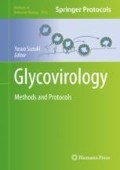Abstract
Influenza D virus (IDV) is a new member of influenza virus that uses cattle as the primary reservoir and infects multiple agricultural animals. Similar to influenza C virus (ICV), IDV also has seven segments in its genome and has only one major surface glycoprotein, called the hemagglutinin-esterase-fusion (HEF) protein, for receptor-binding, receptor-destroying, and membrane fusion. HEF utilizes 9-O-acetylated sialic acids as its receptor and has both receptor binding and esterase activities, thus is a critical determinant of host tropism. Here, we summarize the methods to evaluate the glycan-binding and esterase activities of HEF in vitro. The glycan-bind property is monitored through glycan microarray, MDCK cell-binding assay, Hemagglutination assay, solid-phase lectin binding assay, and immunofluorescence of tissue sections, and its esterase property is analyzed via esterase enzymatic activity assay.
Access this chapter
Tax calculation will be finalised at checkout
Purchases are for personal use only
References
Bouvier NM, Palese P (2008) The biology of influenza viruses. Vaccine 26(Suppl 4):D49–D53
Cohen M et al (2013) Influenza A penetrates host mucus by cleaving sialic acids with neuraminidase. Virol J 10:321
Muraki Y, Hongo S (2010) The molecular virology and reverse genetics of influenza C virus. Jpn J Infect Dis 63(3):157–165
Muchmore EA, Varki A (1987) Selective inactivation of influenza C esterase: a probe for detecting 9-O-acetylated sialic acids. Science 236(4806):1293–1295
Hause BM et al (2013) Isolation of a novel swine influenza virus from Oklahoma in 2011 which is distantly related to human influenza C viruses. PLoS Pathog 9(2):e1003176
Hause BM et al (2014) Characterization of a novel influenza virus in cattle and Swine: proposal for a new genus in the Orthomyxoviridae family. MBio 5(2):e00031–e00014
Sheng Z et al (2014) Genomic and evolutionary characterization of a novel influenza-C-like virus from swine. Arch Virol 159(2):249–255
Collin EA et al (2015) Cocirculation of two distinct genetic and antigenic lineages of proposed influenza D virus in cattle. J Virol 89(2):1036–1042
Song H et al (2016) An open receptor-binding cavity of hemagglutinin-esterase-fusion glycoprotein from newly-identified influenza D virus: basis for its broad cell tropism. PLoS Pathog 12(1):e1005411
Nemanichvili N et al (2021) Tissue microarrays to visualize influenza D attachment to host receptors in the respiratory tract of farm animals. Viruses 13(4):586
Fusade-Boyer M et al (2020) Risk mapping of influenza D virus occurrence in ruminants and swine in Togo using a spatial multicriteria decision analysis approach. Viruses 12(2):128
Bailey ES et al (2020) First sequence of influenza D virus identified in poultry farm bioaerosols in Sarawak, Malaysia. Trop Dis Travel Med Vaccines 6:5
Chiapponi C et al (2019) Detection of a new genetic cluster of influenza D virus in Italian cattle. Viruses 11(12):1110
Hayakawa J et al (2020) Genetic and antigenic characterization and retrospective surveillance of bovine influenza D viruses identified in Hokkaido, Japan from 2018 to 2020. Viruses 12(8):877
Huang C et al (2021) Emergence of new phylogenetic lineage of influenza D virus with broad antigenicity in California, United States. Emerg Microbes Infect 10(1):739–742
Kaplan BS et al (2021) Virus strain influenced the interspecies transmission of influenza D virus between calves and pigs. Transbound Emerg Dis 68(6):3396–3404
Murakami S et al (2020) Influenza D virus of new phylogenetic lineage, Japan. Emerg Infect Dis 26(1):168–171
Nissly RH et al (2020) Influenza C and D viral load in cattle correlates with bovine respiratory disease (BRD): emerging role of orthomyxoviruses in the pathogenesis of BRD. Virology 551:10–15
Silveira S et al (2019) Serosurvey for influenza D virus exposure in cattle, United States, 2014–2015. Emerg Infect Dis 25(11):2074–2080
Trombetta CM et al (2019) Influenza D virus: serological evidence in the Italian population from 2005 to 2017. Viruses 12(1):30
Zhai SL et al (2017) Influenza D virus in animal species in Guangdong Province, Southern China. Emerg Infect Dis 23(8):1392–1396
Smith DF et al (2010) Use of glycan microarrays to explore specificity of glycan-binding proteins. Methods Enzymol 480:417–444
Padler-Karavani V et al (2012) Cross-comparison of protein recognition of sialic acid diversity on two novel sialoglycan microarrays. J Biol Chem 287(27):22593–22608
Killian M (2014) Hemagglutination assay for influenza virus. In: Spackman E (ed) Animal influenza virus. Springer, New York, pp 3–9
Langereis MA et al (2012) The murine coronavirus hemagglutinin-esterase receptor-binding site: a major shift in ligand specificity through modest changes in architecture. PLoS Pathog 8(1):e1002492
Klein A et al (1994) 9-O-acetylated sialic acids have widespread but selective expression: analysis using a chimeric dual-function probe derived from influenza C hemagglutinin-esterase. Proc Natl Acad Sci U S A 91(16):7782–7786
Peng G et al (2011) Crystal structure of mouse coronavirus receptor-binding domain complexed with its murine receptor. Proc Natl Acad Sci U S A 108(26):10696–10701
Chandrasekaran A et al (2008) Glycan topology determines human adaptation of avian H5N1 virus hemagglutinin. Nat Biotechnol 26(1):107–113
Wang M et al (2015) Structural basis for preferential avian receptor binding by the human-infecting H10N8 avian influenza virus. Nat Commun 6:5600
Martin LT et al (2003) Recombinant influenza C hemagglutinin-esterase as a probe for sialic acid 9-O-acetylation. Methods Enzymol 363:489–498
Holwerda M et al (2021) Establishment of a reverse genetic system from a bovine derived influenza D virus isolate. Viruses 13(3):502
Herrler G et al (1988) Serine-71 of the glycoprotein Hef is located at the active-site of the acetylesterase of influenza-C virus. Arch Virol 102(3–4):269–274
Author information
Authors and Affiliations
Corresponding author
Editor information
Editors and Affiliations
Rights and permissions
Copyright information
© 2022 The Author(s), under exclusive license to Springer Science+Business Media, LLC, part of Springer Nature
About this protocol
Cite this protocol
Song, H., Gao, G.F. (2022). Evaluation of the Glycan-Binding and Esterase Activities of Hemagglutinin-Esterase-Fusion Glycoprotein from Influenza D Virus. In: Suzuki, Y. (eds) Glycovirology. Methods in Molecular Biology, vol 2556. Humana, New York, NY. https://doi.org/10.1007/978-1-0716-2635-1_15
Download citation
DOI: https://doi.org/10.1007/978-1-0716-2635-1_15
Published:
Publisher Name: Humana, New York, NY
Print ISBN: 978-1-0716-2634-4
Online ISBN: 978-1-0716-2635-1
eBook Packages: Springer Protocols

